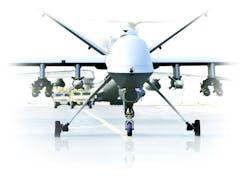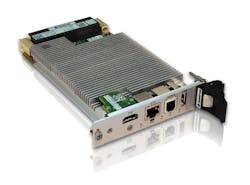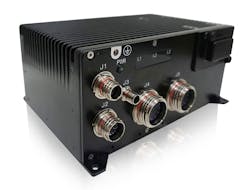Continued Embedded Platform Advancements Help Drive UAS Innovation
Pre-integrated systems meet expanding defense UAV programs
Author: Joe Eicher, Defense Global Business Development at Kontron
The Department of Defense 2017 budget request illustrates that the military shows no signs of backing away from advancing their unmanned vehicle programs. This comes from the success of manned-unmanned defense teaming that has proven these programs to be highly successful in helping military operations become more agile, responsive and safe. From the Air Force and Army to the Marines and Navy, all branches are looking to add more air, sea and land unmanned systems, including smaller and smarter ones to their arsenal.
CAPTION: The diverse and complex nature of UAS designs and the integrated computing systems inside pose some of the most difficult design challenges for developers. The complexity and functionality of these systems grows with each new generation or upgrade, where each must satisfy a varied list of requirements that continually test the limits of embedded computing technologies all within strict budget guidelines and tight program deadlines.
Continuing advancements in open architecture COTS embedded computing are helping to drive UAS system innovation. Even though every UAS design has a defined set of requirements, they do share the need for characteristics that are common benefits delivered by COTS-based computing platforms. Namely these are the ability to provide ever higher processing performance, interoperability, scalability, adherence to strict size, weight and power (SWaP) restrictions and cost-effective long-term availability.
In fact, last year the Pentagon continued its search for next-generation warfighting technologies. They invited technology companies to offer concepts that solve problems in key areas including better methods to manage and use the massive amounts of data generated by the sensors deployed in UAS operations.
Multi-core Computing Capabilities
Sophisticated UAS sensor payloads are important additions enabling military personnel to acquire a wealth of data, including streaming video and high-definition (HD) images. Added to this equation, bandwidth is often limited, and can prevent the transmission, sharing, and display of this type of mission-critical information. Such network limitations are driving the need for efficient data processing directly on the UAS system. If designers are to rely on embedded computing platforms to support new UAS operational needs, they must deliver exceptional computational performance.
Meeting these needs are the latest multi-core COTS platforms that supply the necessary dual data plane 10 gigabit Ethernet (GbE) network bandwidth along with the powerful processing capabilities of parallel virtual machine (VM) execution. High performance COTS solutions also meet the need for a highly-networked UAS infrastructure that will enable any unmanned system to be accessed on the network to facilitate continuing communications to control personnel. Having all vehicles networked ensures there is a ready datalink to transmit captured vision, radar or sensor information.
Multi-core platform features also deliver the capability to consolidate different workloads and applications onto a single system. From available high performance 8-core boards and systems based on the Intel® Xeon® Processor-D, these embedded computing solutions can easily handle increased broadband connectivity needs while supporting other operational capabilities in tandem.
Developers could foreseeably segregate and combine applications on a single system giving command and control personnel access to varying sensor data analytics. It is increasingly important to be able to segregate authorization-based data before it is transmitted to an open-source ground system to protect classified sections. This can be accomplished while also providing other necessary tasks such as vehicle control or monitoring fuel consumption. Multi-core based platforms give UAS developers the features to enable extensive capital and operational efficiencies to be achieved using isolated workloads, which dynamically share common resources. Plus, the virtualization capabilities provided by Intel processors means that a single application design can be easily adapted to hardware evolution needs such as CPU count, memory, form factor and I/O availability future-proofing the embedded computing solution investment. Kontron’s white paper “High Data Rates Over The VPX Infrastructure” outlines how VPX components can reliably perform over wide environmental ranges.
CAPTION: Providing DSP performance, the highly-integrated and SWaP-C optimized Kontron VX3058 brings server class computing capabilities to the battlefield. Based on the advanced 8-core version of the Intel® Xeon® Processor D architecture, the VX3058 features Dual 10 Gigabit Ethernet (GbE), high bandwidth PCI Express (PCIe) 3.0, and high speed DDR4 memory. Designed for demanding military server and other HPEC applications, it enables designers to solve with a single architecture a very diverse set of computing problems such as advanced imaging or sensor processing for unmanned systems.
Interoperability and Re-use
Operational efficiency under tight budget limitations is driving the crucial requirement that the airframes and ground/water unmanned designs perform more than just one function or role. This broader role takes in a variety of mission objects beyond just surveillance. To meet Department of Defense mandates for more cost-effective re-use of unmanned vehicles, OEMs are taking a common design approach that employ standard interfaces and interoperable, ‘plug and play’ payloads as opposed to developing multiple types of systems that only do one or two tasks. Designing for this diverse role requires implementing interoperability with increased computing and communications capabilities to meet greater real-time operational control needs. Unmanned systems are also required to be compatible with ground stations and other systems besides those in the vehicle itself. That means interoperability in embedded platforms must extend to cover multiple functions such as payload sensors for camera and radar systems as well as those monitoring temperature, biological, electromagnetic and chemical threats.
That is where COTS embedded computing platforms as VPX and Computer-on-Modules (COMs) shine. They offer proven interoperability and re-use from an open systems architecture that can support the wide range of hardware and software capabilities that are continually being released from an expanding ecosystem of suppliers. Using advanced open architecture hardware solutions not only provides the interoperability required but also high-level security features that are critical for command-and-control center communications. In addition, standards-based, COTS solutions are also inherently scalable to support various vehicle payload objectives and future application upgrades.
Satisfying these needs is the latest COMs from Kontron. The COMe-bKL6 module offers both high-performance (from a broad range of CPUs) and integrated Intel HD Graphics that can support up to three independent displays with up to 4k resolution, enabling UAS developers to match their operational requirements. These new modules also feature brand-new Intel® Optane™ technology, a non-volatile memory solution based on 3D XPoint™ memory technology. It works up to 1,000 times faster than a NAND flash memory to massively reduce latencies, which is a strong advantage in high-performance computing or image processing UAS scenarios.
Rugged SWaP Options
All the technological advancements integrated into today’s unmanned systems are worthless unless they are rugged enough to operate with the utmost reliability in intense environmental conditions. In addition, almost all UAS designs have exacting rugged SWaP requirements. Therefore, developers struggle with the need to package a high level of computing power and data collection/distribution components into their space-constrained designs that also must be ruggedized. Hand-in-hand with harsh environments is the careful consideration of thermal load and system efficiencies to maximize battery life that result in the highest operational availability. Download the white paper.
To provide consistently reliable performance, COTS platforms must be made up of a rugged baseboard, power module, housing and appropriate I/O connectors. These defined ruggedized components also need efficient thermal management for limited SWaP requirements.
Driving Autonomous Operation
The military is initiating new UAS programs that call for compute intensive on-board intelligence that can provide the ability to make real-time mission adjustments leading to greater levels of autonomous operation. This highlights the expected evolution of UAS deployments and the need for embedded computing solutions to deliver the increased levels of connectivity in highly interoperable standards-based platforms. Offering the technology to accomplish this convergence of capabilities allows military operations to be better integrated with other battlefield applications.
Deep learning (view video) is a method to process very large data sets. From deep learning algorithms, UAS designers need to handle thousands of levels of processing layers and non-linear transforms in order to make sense of information or patterns from enormous amounts of data. Deep learning can be successfully applied for on-platform processing of streaming signal or image data. These systems would have to have the capability to sift through voluminous streams of data to locate threats and autonomously deploy active protection systems.
Up until now, the processing power needed for such complex applications was not small and low-power enough to integrate into embedded computing solutions suitable for UAS systems. By supplying the required algorithms mapped onto the computing architecture, the latest HPEC platforms provide the fast backplane performance desired in a much smaller footprint. A HPEC platform example for deep learning is one based on the aforementioned Intel® Xeon® Processor D-1540. Each of the processor’s 16 cores has two AVX2 units and each unit can process 8 floating point FMA operations at a time. Offering a huge amount of processing power, the 16 cores one can perform 512 floating point operations with each clock cycle making it for a wide range of deep learning applications. These types of HPEC systems are well-suited for VPX-based boards and platforms that can deliver high-speed/low-latency communication via the backplane with PCIe Gen3 or 10Gbit Ethernet links.
Taking UAS Designs into the Future
Advanced COTS-based platforms meet the combat system requirements for reduced lifecycle costs due to their interoperability and modularity, improved communications capabilities and the ability to support complex integration of a variety of hardware and software solutions. Supporting “leap ahead” UAS payload, autonomy, communications, sensor or imaging capabilities expected in future programs, embedded computing platforms based on the latest multi-core processors are delivering the massive processing performance needed to handle highly differentiated workloads while minimizing SWaP.Download the Use Case.
Available in a variety of form factors and based on existing MIL standards, today’s COTS solutions support the need for a common UAS architecture. Open architecture computing is the foundation to increase an unmanned program’s value by enabling the use of enhanced sensor capabilities or intelligent payloads combined with the ability to change or update any of these based on specific mission profiles. Today’s embedded computing platforms not only support modular plug-and-play payload capabilities that expand UAS combat roles, their standards-based and scalable technologies help developers quickly adapt UAS designs in response changing threats.
For more information about Kontron defense products, visithttps://www.kontron.com/industries/defense




